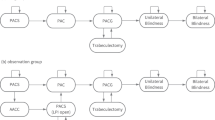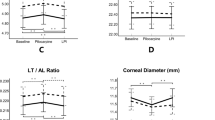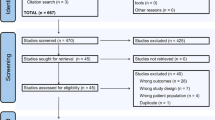Abstract
Purpose
To determine whether prophylactic laser peripheral iridotomy (LPI) for primary angle closure (PAC) is associated with cataract progression.
Methods
In 1999, Mongolian volunteers aged ⩾50 years were invited to participate in a longitudinal study. Glaucoma was excluded in all participants and 712 of them were selected to undergo a full ophthalmic examination as part of the study protocol. Lenses were graded and PAC diagnosed using international classification systems. In 2005, all traced participants underwent a similar dilated examination. Diagnosis of cataract progression was based on the inter-observer variation +2 standard deviations. The association between LPI at baseline and cataract progression was assessed using χ2-test and logistic regression.
Results
Of 712 participants, 158 were diagnosed with occludable angles and treated with LPI. In 2005, 137 participants (19.2%) had died, 315 (315/575=54.8%) were traced, and dilated examination was performed on 276 (48%) of them. Progression of nuclear opacity (NO), cortical, and posterior subcapsular (PSC) opacities were evident in 40 (14.5%, 95% confidence interval (CI)=10.6–19.2%), 89 (32.2%, 95% CI=26.8–38.1%), and 11 participants (4.0%, 95% CI=2.0–7.0%), respectively. Although NO was more likely to progress in those with LPI in a crude analysis (odds ratio (OR)=2.02, 95% CI=1.00–4.11, P=0.05), no evidence of an independent association was detected in multivariate analysis adjusting for age, sex, and baseline Schaffer grading (adjusted OR=1.24, 0.41–3.75, P=0.7). There was no evidence of an association between LPI and progression of PSC or cortical opacities.
Conclusions
There is no evidence that prophylactic LPI is independently associated with cataract progression in this study.
Similar content being viewed by others
Log in or create a free account to read this content
Gain free access to this article, as well as selected content from this journal and more on nature.com
or
References
Resnikoff S, Pascolini D, Etya'ale D, Kocur I, Pararajasegaram R, Pokharel GP et al. Global data on visual impairment in the year 2002. Bull World Health Organ 2004; 82: 844–851.
Foster PJ, Johnson GJ . Glaucoma in China: how big is the problem? Br J Ophthalmol 2001; 85: 1277–1282.
Foster PJ, Oen FT, Machin D, Ng TP, Devereux JG, Johnson GJ et al. The prevalence of glaucoma in Chinese residents of Singapore: a cross-sectional population survey of the Tanjong Pagar district. Arch Ophthalmol 2000; 118: 1105–1111.
Quigley HA, Broman AT . The number of people with glaucoma worldwide in 2010 and 2020. Br J Ophthalmol 2006; 90: 262–267.
Gazzard G, Friedman DS, Devereux JG, Chew P, Seah SK . A prospective ultrasound biomicroscopy evaluation of changes in anterior segment morphology after laser iridotomy in Asian eyes. Ophthalmology 2003; 110: 630–638.
Nolan WP, Foster PJ, Devereux JG, Uranchimeg D, Johnson GJ, Baasanhu J . YAG laser iridotomy treatment for primary angle closure in East Asian eyes. Br J Ophthalmol 2000; 84: 1255–1259.
Lowe RF . The natural history and principles of treatment of primary angle-closure glaucoma. Am J Ophthalmol 1966; 61: 642–651.
Caronia RM, Liebmann JM, Stegman Z, Sokol J, Ritch R . Increase in iris-lens contact after laser iridotomy for pupillary block angle closure. Am J Ophthalmol 1996; 122: 53–57.
Friedman DS . Who needs an iridotomy? Br J Ophthalmol 2001; 85: 1019–1021.
Bobrow JC . Factors influencing cataract formation after Nd:YAG laser peripheral iridotomy. Trans Am Ophthalmol Soc 2008; 106: 93–97; discussion 97–9.
Lim LS, Husain R, Gazzard G, Seah SK, Aung T . Cataract progression after prophylactic laser peripheral iridotomy: potential implications for the prevention of glaucoma blindness. Ophthalmology 2005; 112: 1355–1359.
Nolan WP, Baasanhu J, Undraa A, Uranchimeg D, Ganzorig S, Johnson GJ . Screening for primary angle closure in Mongolia: a randomised controlled trial to determine whether screening and prophylactic treatment will reduce the incidence of primary angle closure glaucoma in an east Asian population. Br J Ophthalmol 2003; 87: 271–274.
Chylack Jr LT, Wolfe JK, Singer DM, Leske MC, Bullimore MA, Bailey IL et al. The Lens Opacities Classification System III. The longitudinal study of cataract study group. Arch Ophthalmol 1993; 111: 831–836.
Foster PJ, Buhrmann R, Quigley HA, Johnson GJ . The definition and classification of glaucoma in prevalence surveys. Br J Ophthalmol 2002; 86: 238–242.
McCarty CA, Mukesh BN, Dimitrov PN, Taylor HR . Incidence and progression of cataract in the Melbourne Visual Impairment Project. Am J Ophthalmol 2003; 136: 10–17.
Leske MC, Chylack Jr LT, Wu SY, Schoenfeld E, He Q, Friend J et al. Incidence and progression of nuclear opacities in the Longitudinal Study of Cataract. Ophthalmology 1996; 103: 705–712.
Klein BE, Klein R, Lee KE . Diabetes, cardiovascular disease, selected cardiovascular disease risk factors, and the 5-year incidence of age-related cataract and progression of lens opacities: the Beaver Dam Eye Study. Am J Ophthalmol 1998; 126: 782–790.
Leske MC, Wu SY, Nemesure B, Li X, Hennis A, Connell AM . Incidence and progression of lens opacities in the Barbados Eye Studies. Ophthalmology 2000; 107: 1267–1273.
Husain R, Aung T, Gazzard G, Foster PJ, Devereux JG, Chew PT et al. Effect of trabeculectomy on lens opacities in an East Asian population. Arch Ophthalmol 2006; 124: 787–792.
Yip JL, Jones E, Foster PJ, Nolan WP, Friedman DS . Cataract after laser iridotomy. Ophthalmology 2006; 113: 1467; author reply 1467–8.
Tsatsos M, Eke T . Cataract after laser iridotomy. Ophthalmology 2006; 113: 1252; author reply 1252.
American Academy of Ophthalmology Glaucoma Panel. Primary Angle Closure. American Academy of Ophthalmology: San Francisco, 2005.
Ang MH, Baskaran M, Kumar RS, Chew PT, Oen FT, Wong HT et al. National survey of ophthalmologists in Singapore for the assessment and management of asymptomatic angle closure. J Glaucoma 2008; 17: 1–4.
Sheth HG, Goel R, Jain S . UK national survey of prophylactic YAG iridotomy. Eye 2005; 19: 981–984.
Nonaka A, Kondo T, Kikuchi M, Yamashiro K, Fujihara M, Iwawaki T et al. Angle widening and alteration of ciliary process configuration after cataract surgery for primary angle closure. Ophthalmology 2006; 113: 437–441.
Lam DS, Leung DY, Tham CC, Li FC, Kwong YY, Chiu TY et al. Randomized trial of early phacoemulsification versus peripheral iridotomy to prevent intraocular pressure rise after acute primary angle closure. Ophthalmology 2008; 115: 1134–1140.
Acknowledgements
We would like to thank Drs Davaasambuu Tsendenkhuu and Tsedendavaa, Chimed Oyunsuren, Tsedengonbo Lhagvasuren, Dr Tsagaan Altantsetseg from Sukbaator District hospital, and Dr Legtsegdulam Altantsetseg from Bayanzurkh District hospital, the staff of Sukbaator District hospital, Bayanhongor hospital, and Bolor Melmii who worked on this project. This work was funded by the Wellcome Trust, British Council for Prevention of Blindness (London), Christian Blind Mission (CBM) (Bensheim), The National Lotteries Fund through Fight for Sight (London). The Yag laser used in this study was donated by the Velux Foundation, Copenhagen. We acknowledge a proportion of our financial support from the Department of Health through the award made by the National Institute for Health Research to Moorfields Eye Hospital NHS Foundation Trust and UCL Institute of Ophthalmology for a Specialist Biomedical Research Centre for Ophthalmology. The views expressed in this publication are those of the authors and not necessarily those of the Department of Health.
Author information
Authors and Affiliations
Corresponding author
Ethics declarations
Competing interests
The authors declare no conflict of interest.
Rights and permissions
About this article
Cite this article
Yip, J., Nolan, W., Gilbert, C. et al. Prophylactic laser peripheral iridotomy and cataract progression. Eye 24, 1127–1135 (2010). https://doi.org/10.1038/eye.2010.59
Received:
Revised:
Accepted:
Published:
Issue date:
DOI: https://doi.org/10.1038/eye.2010.59
Keywords
This article is cited by
-
Neodymium-doped yttrium aluminum garnet (Nd: YAG) laser treatment in ophthalmology: a review of the most common procedures Capsulotomy and Iridotomy
Lasers in Medical Science (2024)
-
Reply to Yip et al
Eye (2011)
-
Reply to Athanasiadis et al
Eye (2011)



